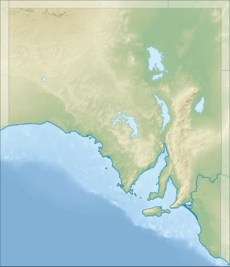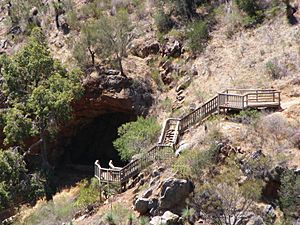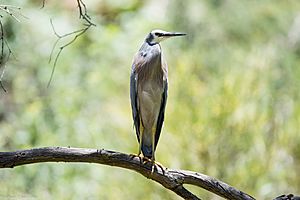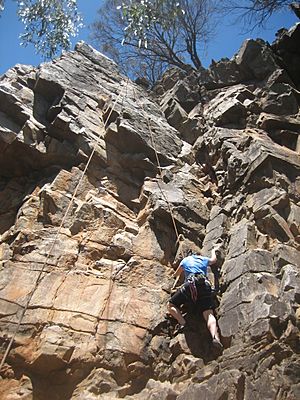Morialta Conservation Park facts for kids
Quick facts for kids Morialta Conservation ParkSouth Australia |
|
|---|---|
|
IUCN Category III (Natural Monument)
|
|
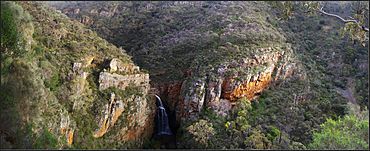
Morialta Conservation Park showing First Falls and Morialta Gorge, note scree slope at far right.
|
|
| Nearest town or city | Adelaide |
| Established | 15 July 1915 |
| Area | 5.33 km2 (2.1 sq mi) |
| Visitation | 300,000 (in 2001) |
| Managing authorities | Department for Environment and Water |
| Website | Morialta Conservation Park |
| See also | Protected areas of South Australia |
Morialta Conservation Park is a special protected area in South Australia, Australia. It's located about 10 kilometers (6 miles) north-east of Adelaide city centre. This park is known for its wild, rugged bushland.
Inside the park, you'll find a narrow gorge with three beautiful waterfalls. Steep ridges and cliffs surround these falls. Morialta is a great place for many outdoor activities. These include bushwalking, watching birds, and rock climbing.
The name "Morialta" likely comes from the Kaurna language. It is thought to mean "eastern land or country."
Contents
A Look at Morialta Conservation Park
Morialta Conservation Park covers about 5.33 square kilometers (2 square miles). It is part of the Mount Lofty Ranges, which are hills east of Adelaide. The park is bordered by Black Hill Conservation Park to the north.
The main feature of the park is Morialta Gorge. Fourth Creek flows along the bottom of this gorge. Along the creek, you can find three waterfalls. They are called First, Second, and Third Falls.
You can enter the park by car from Morialta Road. There are also walking paths from Norton Summit Road.
What is the Climate Like?
Morialta has a Mediterranean climate, just like Adelaide. This means it has warm, dry summers and mild, wet winters. Average temperatures are around 17 degrees Celsius (63°F) in winter. In summer, they can reach 28 degrees Celsius (82°F).
The park gets about 800 millimeters (31 inches) of rain each year. Most of this rain falls between May and September. During summer (December to February), temperatures can sometimes go above 40 degrees Celsius (104°F).
History of Morialta Park
The history of Morialta Conservation Park goes back many years. In 1911, a local landowner named John Smith Reid offered to donate some of his land. He wanted to create a national reserve for everyone to enjoy.
Reid officially donated 218 hectares (539 acres) in 1913. On July 15, 1915, this land became a National Pleasure Resort. It was named the Morialta Falls Reserve. Much building work happened in the 1920s and 1930s. However, floods and bushfires have since damaged many of these original structures.
More land was added to the park in 1966. Later, in 1972, the park was renamed. It became the Morialta Conservation Park under a new law. This law helps protect special natural areas.
The park has faced challenges over the years. Major floods in 1980 and 2005 caused damage to paths and walkways. Each time, the park has been rebuilt and restored.
First People of the Land
The land where Morialta Conservation Park now stands was originally home to the Kaurna people. They are the traditional owners of this area. The name "Morialta" comes from their language. It means "eastern land or country."
The Kaurna people used this area for hunting. They also collected firewood, especially in winter. During the colder months, they would move from the coast to the hills. It is believed they also used "fire-stick farming" here. This is a way of managing the land by carefully using fire.
In 1839, the new British government in South Australia granted this land to farmers. Later, in 1847, John Baker bought the land. He built a large house, Morialta House, and barns near Fourth Creek.
Fun Activities at Morialta
Morialta Conservation Park offers many exciting things to do. It's a great place for families and friends to explore.
- Bushwalking: There are many walking paths throughout the park. You can explore the gorge, see the waterfalls, and enjoy the natural beauty.
- Picnics: The park has lovely spots perfect for a picnic lunch.
- Bird Watching: Keep an eye out for different types of birds. You might spot a White-Faced Heron or other native birds.
- Rock Climbing: Morialta is a very popular spot for rock climbing.
- Nature Play Area: A large nature play area has recently been built at the bottom of the park. It's a fun space for kids to play and connect with nature.
Rock Climbing Adventures
Morialta is one of the most popular places for rock climbing in South Australia. It's only 10 kilometers (6 miles) from Adelaide city center. The cliffs are made of a strong rock called quartzite. Many routes have special rings at the top. These rings make it easy to do top-roping. This is a safe way to climb where the rope goes through the rings at the top and back down to a person on the ground.
There are several climbing areas, called "crags," on both sides of the gorge. Some popular crags include Far Crag, which has over 67 climbing routes. These routes range in difficulty from easy to very challenging.
A Brief History of Climbing
Rock climbing at Morialta began in 1962. A group from the Adelaide University Mountain Club started exploring the cliffs. At first, they climbed the cliffs closer to the western (Adelaide) end of the park.
In 1968, climbers discovered Far Crag. They named it "Far Crag" because it was the furthest from where they usually started. Many new climbing routes were created up until the 1970s. In 1971, international climbers visited and helped improve the climbing standards. By the late 1970s, very difficult climbs were being completed.
Interestingly, a significant climbing area called The Lost Walls wasn't found until 1986. This is why it got its name! The most difficult new route in the park was set in 1994. Today, climbers often access the park from Norton Summit Road.
How Climbers Climb Here
Most climbing in Morialta Gorge is done using a method called top rope. This is made easy because there are strong steel rings at the top of many climbs. These rings help climbers set up their ropes safely. This makes outdoor climbing possible for many different people.
While top-roping is common, some routes are set up for sport climbing. This means they have bolts drilled into the rock for safety. Other routes are good for traditional climbing, where climbers place their own safety gear. Often, a route can be used for sport climbing, traditional climbing, or top-roping.
Images for kids


